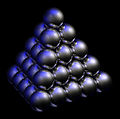Close-packing of equal spheres
Close-packing of equal spheres refers to the arrangement of spheres of equal size in a manner that maximizes the space they occupy, leaving the least amount of void space. This concept is significant in various fields, including crystallography, materials science, and mathematics, particularly in the study of packing problems and lattice arrangements. The two most common types of close packing are hexagonal close packing (HCP) and cubic close packing (CCP), also known as face-centered cubic (FCC) packing.
Overview[edit]
In three-dimensional space, the maximum packing efficiency – the fraction of space filled by the spheres – that can be achieved by close-packing is approximately 74.05%. This efficiency is the same for both hexagonal close packing and cubic close packing. The arrangement of the spheres in these structures is such that each sphere is surrounded by 12 other spheres, which forms the most efficient lattice arrangements known for equal spheres.
Hexagonal Close Packing (HCP)[edit]
In the hexagonal close packing arrangement, each layer of spheres is arranged in a hexagonal lattice. The next layer places spheres in the depressions of the first layer, and subsequent layers repeat the alternating pattern. This arrangement is denoted by the repeating ABAB... sequence, where layers A and B are distinct in their orientation.
Cubic Close Packing (CCP)[edit]
Cubic close packing, or face-centered cubic packing, involves three alternating layers of spheres, denoted by the sequence ABCABC.... In this arrangement, the third layer is placed in the depressions of the second layer that are not directly above spheres in the first layer, creating a cubic structure.
Mathematical Description[edit]
The mathematical study of close-packing of equal spheres involves calculating the packing density and understanding the geometric arrangement. The packing density, \(\phi\), is given by the formula:
\[\phi = \frac{\pi}{3\sqrt{2}} \approx 0.74048\]
This formula represents the maximum packing efficiency achievable in three-dimensional space.
Applications[edit]
Close-packing principles are applied in various scientific and industrial fields. In crystallography, understanding the close-packed structures of atoms is essential for determining the properties of materials. In materials science, the packing of particles influences the characteristics of composites and the formulation of pharmaceuticals. Additionally, the concept is relevant in the packing and stacking of spherical objects in storage and shipping industries.
See Also[edit]
References[edit]
<references/>

This article is a mathematics-related stub. You can help WikiMD by expanding it!
-
Close-packing of equal spheres
-
Close-packing of equal spheres
-
Close-packing of equal spheres
-
Close-packing of equal spheres
-
Close-packing of equal spheres
-
Close-packing of equal spheres
-
Close-packing of equal spheres
-
Close-packing of equal spheres
-
Close-packing of equal spheres
-
Close-packing of equal spheres
-
Close-packing of equal spheres
-
Close-packing of equal spheres
Ad. Transform your life with W8MD's Budget GLP-1 injections from $75


W8MD offers a medical weight loss program to lose weight in Philadelphia. Our physician-supervised medical weight loss provides:
- Weight loss injections in NYC (generic and brand names):
- Zepbound / Mounjaro, Wegovy / Ozempic, Saxenda
- Most insurances accepted or discounted self-pay rates. We will obtain insurance prior authorizations if needed.
- Generic GLP1 weight loss injections from $75 for the starting dose.
- Also offer prescription weight loss medications including Phentermine, Qsymia, Diethylpropion, Contrave etc.
NYC weight loss doctor appointmentsNYC weight loss doctor appointments
Start your NYC weight loss journey today at our NYC medical weight loss and Philadelphia medical weight loss clinics.
- Call 718-946-5500 to lose weight in NYC or for medical weight loss in Philadelphia 215-676-2334.
- Tags:NYC medical weight loss, Philadelphia lose weight Zepbound NYC, Budget GLP1 weight loss injections, Wegovy Philadelphia, Wegovy NYC, Philadelphia medical weight loss, Brookly weight loss and Wegovy NYC
|
WikiMD's Wellness Encyclopedia |
| Let Food Be Thy Medicine Medicine Thy Food - Hippocrates |
Medical Disclaimer: WikiMD is not a substitute for professional medical advice. The information on WikiMD is provided as an information resource only, may be incorrect, outdated or misleading, and is not to be used or relied on for any diagnostic or treatment purposes. Please consult your health care provider before making any healthcare decisions or for guidance about a specific medical condition. WikiMD expressly disclaims responsibility, and shall have no liability, for any damages, loss, injury, or liability whatsoever suffered as a result of your reliance on the information contained in this site. By visiting this site you agree to the foregoing terms and conditions, which may from time to time be changed or supplemented by WikiMD. If you do not agree to the foregoing terms and conditions, you should not enter or use this site. See full disclaimer.
Credits:Most images are courtesy of Wikimedia commons, and templates, categories Wikipedia, licensed under CC BY SA or similar.
Translate this page: - East Asian
中文,
日本,
한국어,
South Asian
हिन्दी,
தமிழ்,
తెలుగు,
Urdu,
ಕನ್ನಡ,
Southeast Asian
Indonesian,
Vietnamese,
Thai,
မြန်မာဘာသာ,
বাংলা
European
español,
Deutsch,
français,
Greek,
português do Brasil,
polski,
română,
русский,
Nederlands,
norsk,
svenska,
suomi,
Italian
Middle Eastern & African
عربى,
Turkish,
Persian,
Hebrew,
Afrikaans,
isiZulu,
Kiswahili,
Other
Bulgarian,
Hungarian,
Czech,
Swedish,
മലയാളം,
मराठी,
ਪੰਜਾਬੀ,
ગુજરાતી,
Portuguese,
Ukrainian












